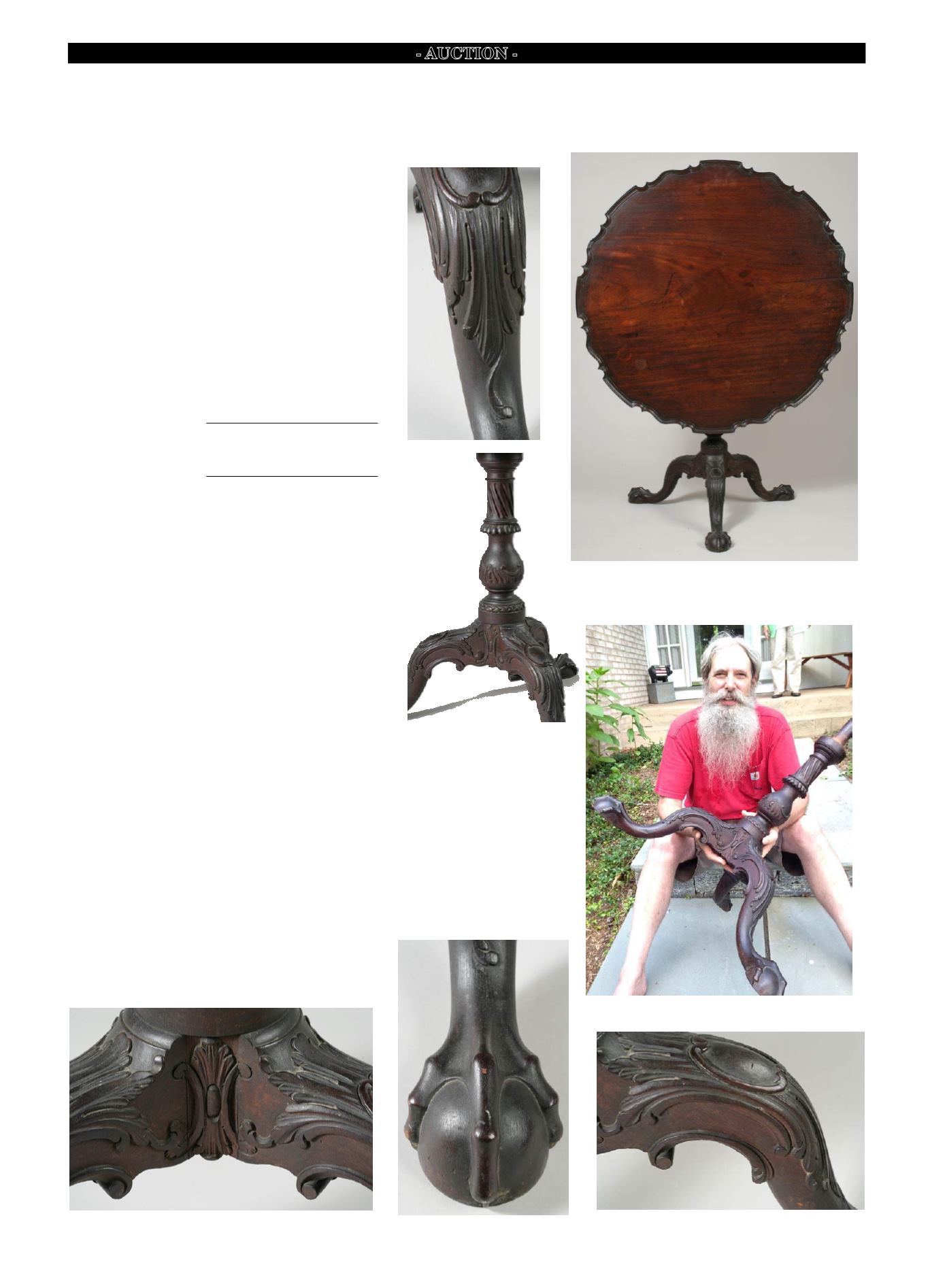

Maine Antique Digest, April 2015 29-A
- AUCTION -
☞
O
n January 31, after most of the Americana collec-
tors had left New York City, Leigh Keno sold the most
expensive lot of American furniture offered duringAmericana
Week. The previously unknown and unpublished Potter-Crouch-Jor-
dan family Philadelphia mahogany tea table that descended in the
family of the original owners for 250 years sold to a special client
on the phone with Keno for $1,895,000 (est. $500,000/2,000,000).
Keno called this sale a “boutique auction”—just 13 lots offered live
and on line through LiveAuctioneers from a small catalog that came
out the day before. It was held at his 127 East 69th Street townhouse.
The discovery of the tea table was serendipitous. A photograph
came over the transom to Keno last summer, and he got in his car
and went after it. He found a rococo Philadelphia tilt-top tea table in
untouched condition in the possession of a bearded fellow in Maine
and convinced him that he could get him the best price, but it would
take patience. Keno delivered.
The bearded fellow, pictured in the front of the sale catalog, came
to the sale with 30 of his relatives to see the table sell on the phone.
It was the only million-dollar lot sold during Americana Week 2015.
It became number 33 on the
M.A.D.
list of million-dollar
pieces of American furniture.
It was the first addition to
the list since January 2013,
when Sotheby’s sold Samuel
Talcott’s cherrywood desk and bookcase for $1,082,500 to Keno
and Christie’s sold a mahogany bureau table from the shop of John
Townsend, signed by his younger brother Jonathan, for $2,210,500.
Keno spent six months having the tea table documented. The story
unfolded slowly. Researcher Amy Coes of Philadelphia traced its
ownership to Edward Crouch (1764-1827) and his wife, Margaret
Potter (1775-1797), of Dauphin County, Pennsylvania. The couple
had inherited it from one of their sets of parents. Margaret was the
daughter of Major General James Potter (1729-1789), a Revolution-
ary war patriot and wealthy Pennsylvania landowner, and his sec-
ond wife, Mary Patterson (1739-1791). They married in 1765, but
Keno believes Potter already owned the table, having bought it in
1755, when he married his first wife, Elizabeth Cathcart, who died
in 1764. But it could have been made for Colonel James Crouch
(c. 1728-1794), another Pennsylvania landowner, and his wife, Han-
nah Brown (1727-1787), when they married in 1757 to furnish their
house, Walnut Hill, in Dauphin County.
The table, made in the 1750s, descended in the family in a remark-
able state of preservation. It was never refinished, waxed, or var-
nished, only dusted over the years. The luck of the untouched finish
seemed even more remarkable when Keno discovered the mate to
this table in storage at the Metropolitan Museum of Art; that one was
refinished. The carving on the legs and on the pedestal (including the
unusual twist at the top of the pedestal) is the same, and so are the
exceptionally large scallops on its oversize top.
Who made these tables? Who carved them? Keno was determined
to find out. Furniture historian Alan Miller has attributed the carv-
ing to an as-yet-unidentified carver, whom he’s nicknamed “Spike”
because of his spiky naturalistic carving. Spike had been identified
as the carver of the Gratz family dressing table at Winterthur, the
Lawrence-Palmer high chest at the Metropolitan Museum of Art, and
the Wistar-Sharples desk-and-bookcase at the Philadelphia Museum
of Art. According to Keno’s catalog, Spike’s use of C-scrolls ending
in leafage, with gouge cuts near the end of the leaf tips and veining,
makes his carving look spiky.
The table’s single-board mahogany top is larger than the top of
most Philadelphia tea tables. It measures 37 3/8" in diameter. Most
Philadelphia tea tables average 32" in diameter, and they rarely
exceed 34". Its deeply carved piecrust edge is shaped into eight
repeating 5" broad scallops alternating between 9" double-peaked
cyma curve passages. The table tilts and turns on its box, called a
“birdcage,” supported by turned balusters that echo the shape of the
baluster on its shaft. Its tripod base and the bottom half of the balus-
ter are carved with rococo scrolls, cabochons, and leafage, and the
spiral fluting above the gadrooned canopy above its vasiform shaft is
Keno Auctions, New York City
Fresh-to-Market Philadelphia Tea Table Sells for
$1,895,000
by Lita Solis-Cohen
Photos courtesy Keno Auctions
The 1755-57 Potter-Crouch-Jordan family Philadelphia
mahogany tea table, 29" high, top 37 3/8" inches in diam-
eter, sold for $1,895,000 (est. $500,000/2,000,000).
A member of the consignor’s
family is shown holding the base
of the table. This photograph
was used as the frontispiece of
the catalog.
The discovery of
the tea table was
serendipitous.










